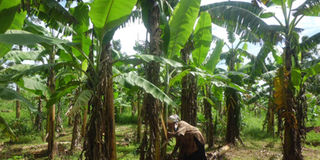Uganda to host Africa’s first gene bank

Establishing a gene bank ensures protection of those varieties deemed to be under threat of extinction and also help farmers access a wide range for whatever purpose they need them. File Photo
A banana germplasm gene-bank, the first of the kind in Africa, is now operational in Uganda. It is to collect and conserve banana species in eastern and central Africa, especially those threatened with extinction.
The field gene bank for ex-situ (in the garden) conservation, is a joint initiative of Agro-Genetic Technologies (AGT), a private company, and the Entebbe-based Association for Strengthening Agricultural Research in Eastern and Central Africa (Asareca).
Farmer-preferred
Funded by Swedish International Development Agency (Sida), it is under a project named “Capacity Development for Sustainable Plant Genetic Resources Utilisation and Conservation in Eastern Africa.”
Erostus Nsubuga, chief executive officer, AGT says the Sida grant runs to 2018.
“The bananas in this gene-bank are the farmer-preferred varieties and landraces that have been collected from the target countries: Burundi, Ethiopia, Kenya, Rwanda, Tanzania and Uganda,” he said.
Conservation
AGT has partnered with non-governmental organisations, donor agencies and universities to establish in-vitro (test-tubes) and ex-situ conservation of bananas in Africa.
They will conserve banana cultivars for protection from extinction and expect this will be a source of planting materials for future generations.
“The objective of the field collection is to obtain maximum diversity from minimum sample,” Nsubuga explains.
Both random and non-random sampling were used to collect bananas from farmers’ fields.
Random collection targeted the total variation available in the population while non-random collection targeted particular economic traits of importance.
The latter includes disease and pest resistance as well as farmer- and market-preferred traits.
There is already a five-acre piece of land with two-year-old banana plantation in Seeta-Nazigo, Nakisunga sub county, Mukono District.
Screening
At the official launch, the residents, most of them farmers, welcomed the gene-bank in the area.
Rashid Kigongo, an extension agent, asked them to collect banana cultivars and deliver them to the bank for screening and inclusion.
“This facility is important and does not only belong to us in Uganda, but east and central Africa. The bananas will be screened for their genus (plant-family) for pests and diseases first, before inclusion in the collection,” he said.
Donald Byamugisha, projects coordinator, AGT, disclosed that sampling for banana varieties was also done in eastern, western and central Ugand.
Response to decline
“We gathered more than 30 accessions which is already planted here,” he said.
Clet Wandui Masiga, a plant genetist, and Dr Sandra Kamenya, a lecturer at Uganda Christian University, explain that gene-banks were established in response to continuous displacement of plants.
This usually arises from factors like modern agriculture, urbanisation and industrialisation.
A consequence is environmental degradation and hence extinction of some varieties.
Know differences
“They are effective and sustainable forms of conservation of plants outside their indigenous habitats. Specifically, field gene-banks are a method of planting plants for the conservation of genes. For this purpose, we construct ecosystems artificially,” Wandui adds.
On her part, Kamenya points out that through this method, one can compare the difference among plants or various species. It needs more land, adequate soil, weather.
Among the varieties Uganda boasts of include: Mpologoma, mbwazirume, kibuzi, kisansa, nakabululu, nfuka, nakitembe, musakala, M-9 (hybrids); sukali-ndizi, bogoya, kivuvu, kayinja and FHIA.




